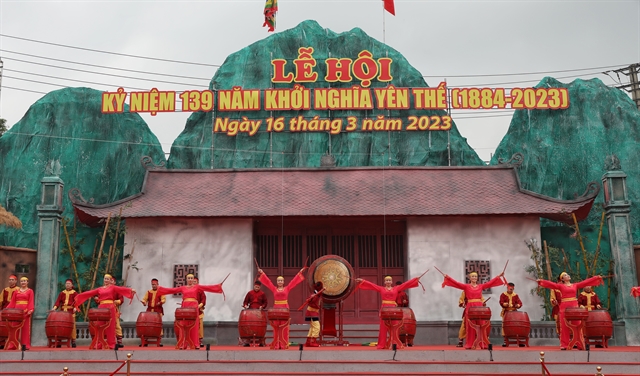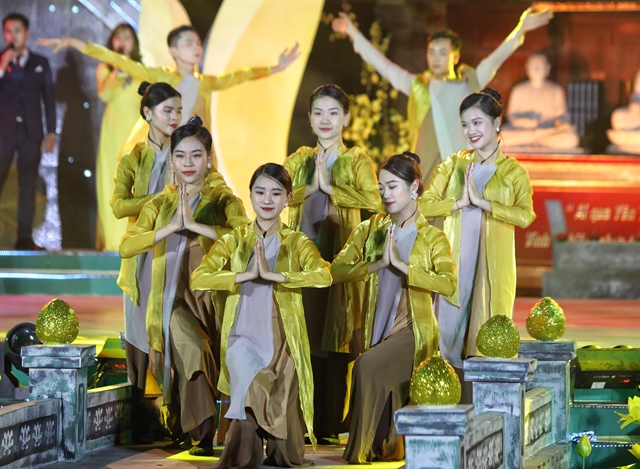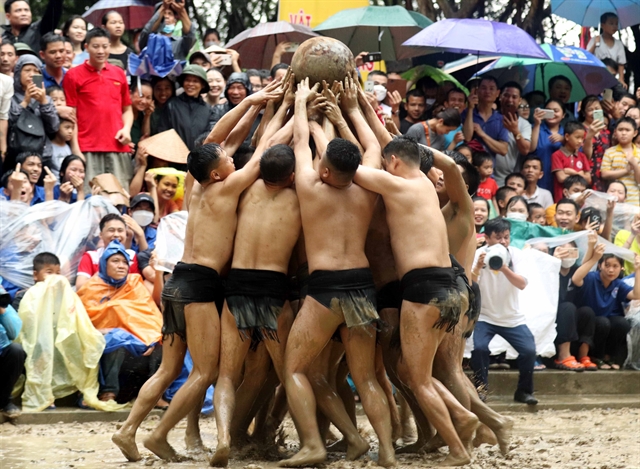 Life & Style
Life & Style


|
| Drum performance opens Yên Thế Uprising Festival 2023. Photos courtesy of Bắc Giang Province |
BẮC GIANG — Northern Bắc Giang Province will boost cultural heritage preservation and development by 2025, according to Trương Quang Hải, Director of the provincial Department of Culture, Sports and Tourism.
The province will continue to coordinate with the two northern provinces of Quảng Ninh and Hải Dương to complete a dossier seeking UNESCO world heritage recognition for Yên Tử - Vĩnh Nghiêm - Côn Sơn and Kiếp Bạc Monument and Landscape Complex.
It will focus on urging and supporting investors to accelerate the construction progress in the West Yên Tử Spiritual - Ecological Tourism Area, to repair and embellish a number of relics belong to Yên Thế National Historical Relic Site, to restore Bồ Đà National Specific Relic Site in Việt Yên District, Vĩnh Nghiêm Pagoda Specific National Relic Site and other relic sites in the province from now to 2025.
Additionally, Xương Giang Victory National Specific Relic Site in Bắc Giang City and Safety Monument Zone II in Hiệp Hòa District will be preserved and restored in accordance with the provincial plan.
"Bắc Giang is an ancient land with a long traditional culture that is diverse, rich and unique," said Mai Sơn, deputy-chairman of Bắc Giang Province. "It has cultural heritage that is recognised nationally and internationally."
The province has 2,237 historical and cultural relics spread throughout the province. Vĩnh Nghiêm Pagoda was built in the Ly dynasty in the 11th century under the reign of King Lý Thái Tổ (1010-1028) in the village of Đức La, Trí Yên Commune, Yên Dũng District.
During the Trần Dynastry, it was a place to worship Buddhism and venerate the founders of Trúc Lâm Zen Buddhism, including King Trần Nhân Tông and the monks Pháp Loa and Huyền Quang.

|
| Buddhist music performance at Vĩnh Nghiêm Pagoda Specific National Relic Site in Yên Dũng District. |
The pagoda houses a valuable collection of over 3,000 engraved boards recognised by UNESCO as World Memory Heritage in the Asia-Pacific region in 2012.
Bổ Đà Pagoda in Việt Yên is home to a garden of 100 towers, regarded as the largest and most beautiful of its kind in Việt Nam. It keeps the oldest Buddhist woodblock that lasted for hundreds of years.
Yên Thế Uprising National Special Relics Site aims to honour the significant history of the uprising and pay homage to the uprising’s leader, Hoàng Hoa Thám, and his troops, who fought the French colonialists for nearly three decades, from the late 19th century to the early 20th century.
It is comprised of 41 relic sites in Yên Thế, Tân Yên, Việt Yên and Yên Dũng Districts.
National Relic Area of Xương Giang Victory Site witnessed the decisive battle of the Lam Sơn army 597 years ago, resulting in a resounding victory over the 100,000-strong Minh army. This triumph forced the enemy general to surrender and withdraw his forces to China, effectively ending the 20-year domination of the Minh Dynasty over Việt Nam.
The special national relic site Safety Zone II (ATK II) in Hiệp Hòa District consists of many historical landscapes in 16 communes. It used to be a hub for the offices of the central government before the national uprising.
The province so far has 746 ranked relic sites and landscapes including five special national relic sites with 34 component relic sites; 96 national relic sites; 616 provincial relic sites and four national treasures.
By 2025, the province targets to have more relic sites and treasures recognised at the national level including specific relic sites, national relic sites and national treasures.
Additionally, the province will submit one documentary heritage recognised by UNESCO. Meanwhile, it also aims to have more two or three cultural heritages recognised at the national level.
Under the provincial plan to preserve and develop cultural heritage, some of the ten cultural heritages will be restored. Plus, the province will also promote archaeology excavation.
Bắc Giang is also interested in preserving and promoting traditional arts and the typical historical and cultural relics of the province to both serve traditional art education and promote socio-economic development.
It connects heritage preservation and socio-economic development in the province. In two years of carrying out provincial plan 238/KH-UBND to restore relic sites in the 2021-2025 period, over 100 relic sites have been restored with total capital of more than VNĐ240 billion, of which VNĐ110 billion were from the State budget and the rest was socialised.
Folk art is rich and diversified including quan họ (love duet singing) and ca trù (ceremonial singing). Quan họ is on UNESCO's list of Intangible Cultural Heritage of Humanity and ca trù was recognised by UNESCO in 2009 as an intangible cultural heritage in urgent need of safeguarding.
Currently, the province has nearly 150 art clubs with two thousand members aiming to preserve and develop folk art.
Bắc Giang has organised over 500 festivals each year including those recognised as national intangible heritage such as the Thổ Hà Festival, Yên Thế Festival and Vĩnh Nghiêm Pagoda Festival.

|
| Villagers play folk game in Vân Village. |
Traditional craft villages Vân Village Wine, Thổ Hà Peanut Sweet and Rice Cracker, Ngòi Village Pottery, Chũ Noodle Village, and Đa Mai Vermicelli Village in the province are also popular.
"Bắc Giang Province needs to invest in tourism spot development," said Associate Professor Bùi Thanh Thủy head of Hà Nội Culture College's Tourism Faculty.
"It is necessary to build a synchronous ecosystem of tourism, resorts, hotels, entertainment, shopping and culinary delights. We also need to support the preservation and promotion of cultural values to boost tourism while building valuable tourism programmes and events to ensure the uniqueness of Bắc Giang." - VNS




